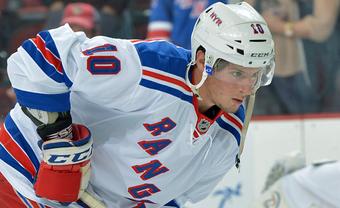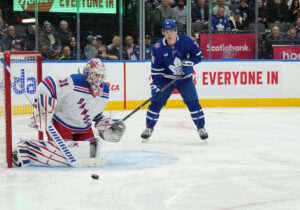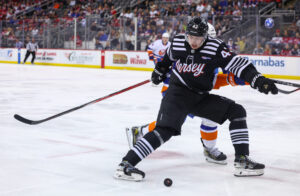Player development seems to always result in more questions than answers. How likely is it for a top pick to pan out? What makes a player a “steal”? Last Word On Hockey will be starting a new series on how to properly develop prospects from all different spots throughout the draft. This week’s piece involves top-15 picks and how they were used early in their careers.
Player Developments Of Top-15 Picks
In the span of 2005 through 2015, there were 21 total selections made between 11th overall and 15th overall on forwards playing in North America. Looking at all 21 forwards, they were split into different categories. Today, we’ll look at the category of “Rushed”. That category had six players, with four making their NHL marks in their DY+2 seasons. Those four players were Lawson Crouse, Dylan Larkin, Zemgus Girgensons and J.T. Miller. In this piece, we will be looking at Girgensons and Miller.
Player Development Of Zemgus Girgensons
Girgensons, drafted 14th overall by the Buffalo Sabres in the 2012 NHL draft, came out of the Dubuque Fighting Saints organization of the USHL. In his DY-1 season, he recorded 21 goals and 28 assists for 49 points in 51 games, which was good for 0.961 points per game. That rate ranked fourth out of those 21 forwards in DY-1 production. He followed that season up with 24 goals and 31 assists for 55 points in 49 games as the captain of the Fighting Saints. That was good for 1.122 points per game, ranking 10th out of those same 21 forwards in DY production.
Following that USHL performance, he would join the Sabres AHL affiliates, the Rochester Americans. In his AHL rookie season, he would be the assistant captain and score six goals and 11 assists for 17 points in 61 games. That was good for 0.279 points per game, ranking last out of 20 forwards still not playing in the NHL in DY+1 production. However, he was the only player who played in the AHL in his DY+1 season out of the 20. After that year, Girgensons would be promoted to the NHL and never looked back.
How Was Girgensons Used?
In his first NHL season, he would play 70 games, scoring eight goals and 14 assists for 22 points. He did that while averaging 15:19 time on ice per game. Analytically, he looks better than his raw stats entail. Girgensons would record an even-strength offence goals above replacement (EVO) score of 4.3, which is very solid. And, it didn’t come at the cost of shaky defensive play, as he recorded an even-strength defence goals above replacement (EVD) score of 1.6. With his solid even-strength play, Girgensons would also record a wins above replacement (WAR) of 1.2, and a goals above replacement (GAR) of 6.3. Those are really solid totals for a rookie.
In his second NHL season, Girgensons would play just 61 games, averaging 19:05 per game. With that top-line role, he would score 15 goals and assists for 30 points, a really solid mark considering how many games he played. However, he would take a step back analytically. His EVO dropped (1.6) but stayed above replacement level. However, that cannot be said about his EVD (-3.4). With the big drop in his EVD, his WAR (-0.2) and GAR (-0.9) both went below replacement level.
Player Development Aside, Girgensons Finds A Role
In his third season, Girgensons would play 71 games, averaging 15:02 per game, back down to his rookie season average. In that reduced role, he would score seven goals and 11 assists for 18 points. Analytically, his EVO (-0.4) continued to fall and dropped below replacement level. However, his EVD (2.7) was much improved. That defensive improvement led his WAR (0.7) and GAR (3.5) to go back above replacement level.
Following that third season, he would remain in the league, with the Sabres, to this day. In total, he has since played 343 games, scoring 41 goals and 45 assists for 86 points. His ice time diminished to an average of 13:46 per game, and his 30-point season remains a career-high. However, there are positives to gleam from this. Girgensons has been a solid defensive center ever since establishing himself as such in his third season. Despite the Sabres efforts, giving him a career-high 19+ minute average in his second year, he was not built to play those top minutes. His offence never really translated. But he has a role and he has been solid ever since.
Player Development Of J.T. Miller
Miller, drafted 15th overall by the New York Rangers in 2011, came out of the USNTDP program. In his DY-1 season, Miller recorded five goals and seven assists for 12 points in 29 USHL games. That’s good for 0.414 points per game, ranking 16th out of 21 forwards in DY-1 production. He followed that season up with three goals and 12 assists for 15 points in 21 USHL games, which is 0.714 points per game. That ranked 20th out of 21 forwards for DY production.
After that season, Miller would actually change his path from the NCAA to the OHL, where he joined the Plymouth Whalers. In 61 OHL games, he scored 25 goals and 37 assists for 62 points, which is 1.016 points per game. That ranked 14th out of 20 forwards who were not yet playing in the NHL in DY+1 production. The Rangers would bring him to professional hockey following that season.
How Was Miller Used?
30-in-30: Having spent time w/ AHL affiliate, will J.T. Miller be @NYRangers X-Factor? Read: http://t.co/SQa9DMrTbe pic.twitter.com/5sktv3CPV8
— NHL (@NHL) August 7, 2014
Miller would split his first professional season between the AHL and NHL. In the AHL, he would play 42 games, scoring eight goals and 15 assists for 23 points. Meanwhile, he would also play 26 NHL games, scoring two goals and assists for four points. He did that while averaging 13:31 time on ice per game. Analytically, it would paint an even clearer picture: Miller was not quite ready. His EVO (-0.9) and EVD (-1.2) were both below replacement level, which led to his WAR (-0.2) and GAR (-1.3) to also be below that threshold.
In his second season, he would again split time. In the AHL, he would play 41 games, scoring 15 goals and 27 assists for 42 points. Then, at the NHL level, he would play 30 games, scoring just three goals and assists for six points, while averaging just 11:27 per game. His analytics would get worse, with his EVO (-2.6) and EVD (-1.2) remaining below replacement level. His WAR (-0.3) and GAR (-1.5) would get slightly worse as well.
Minor Break-Out In Year Three
In his third season, Miller would yet again split between the AHL and NHL level. Playing in just 18 AHL games, he would score six goals and nine assists for 15 points. At the NHL level, Miller would play 58 games, scoring 10 goals and 13 assists for 23 points, averaging 12:42 per game. Analytically, he would break out in a bigger way than raw stats could illustrate. His EVO (4.4) and EVD (0.5) were outstanding compared to the two prior seasons. That led to his WAR (1.3) and GAR (6.9) to be much improved as well.
After that season, Miller would remain with the Rangers for two and a half more seasons. He played 227 games with the Rangers in that span, scoring 57 goals and 82 assists for 139 points. That’s when he got traded, along with Ryan McDonagh, to the Tampa Bay Lightning. Playing with the Lightning for just 94 games, he would score 23 goals and 42 assists for 65 points. His ice time from with the Rangers (14:50) to the Lightning (15:23) was minor, but his next team would make a huge difference.
After his one full season in Tampa Bay, he would be dealt to the Canucks the following offseason. Ever since joining the Canucks, in 202 games, he’s scored 74 goals and 143 assists for 217 points. His ice time per game went up to 20:43. While his player development was not excellent with the Rangers, the Canucks made up for it. He has established himself as one of the top forwards in the league. His player development with the Rangers was not great, but he found success with his later teams. They essentially gave him the boost he needed.
Junior league stats via Elite Prospects, NHL stats via Hockey Reference, NHL analytics via Evolving Hockey






